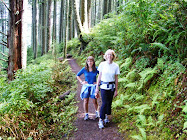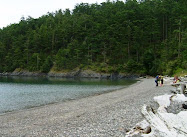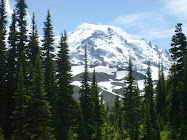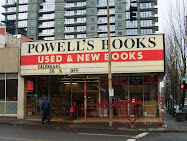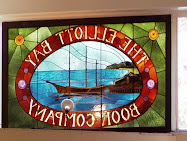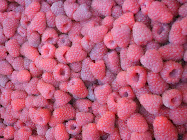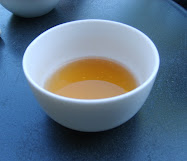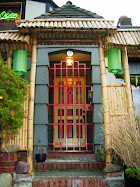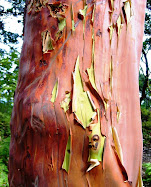Want to feel transported back to an earlier, simpler time? On Washington's Camano Island, Cama Beach State Park was converted from an old 1930s-era fishing resort and now features cozy beach cabins, miles of trails through thick lowland forest, and a relaxed, slow-down vibe.
On one of our spectacular September weekends, I grab a friend and head up there from Seattle to check it out, based on the raves from a friend who stayed there recently.
Our first stop is the Cama Beach Cafe for breakfast, set in a gorgeous new lodge in the woods above the beach. This very popular cafe uses seasonal veggies and fruit, Camano Island eggs, and sausages made in nearby Stanwood. My veggie omelet is excellent, and my table mates rave about the Swedish pancakes.
 |
| Cama Beach Cafe's tasty local fare. |
Alas, the guy just ahead of me in line snagged the last of their famous blueberry scones. I'm sorely tempted by the gorgeous rhubarb pie in the display case, but discipline rules. Next trip.
 |
| Cama Beach lodge |
It's just a short walk to the beach and the Center for Wooden Boats, which offers boat rentals and educational programs. Friendly Shane, who manages the facility, is happy to chat with us and show us their boats.
 |
| Center for Wooden Boats at Cama Beach |
On a clear day, the westward-facing little cabins overlook Saratoga Passage, Whidbey Island, and peek-a-boo views of the Olympic Mountains beyond.
With a low tide this morning, we walk off breakfast by strolling down the beach for starters. Walking along the rocks and sand requires more effort with each step, so I figure we're burning more calories. :)
With many trails winding through woods, along the bluffs, and over to Camano Island State Park (where there are even more trails) to choose from, we opt to walk through lush lowland forest to the bluff trail for views.
It all seems so right and peaceful walking along the well-worn paths through the healthy forest, with just the soft earth underfoot. We hear the distinctive, eeh-eeh-eeh cry of a pileated woodpecker reverberating through the forest canopy above.
After passing several viewing platforms, it's time to turn around and head back to the city. Too soon. What a perfect spot for a quiet getaway in the winter or midweek in the warmer months!
Have you been to Cama Beach? Do you have a favorite beach park?
For more photos and Northwest happenings between blog posts, Like the Pacific Northwest Seasons page on FaceBook.
Happy trail and thanks for visiting Pacific Northwest Seasons.
When You Go
Cama Beach State Park is open year-round, and it's easier to book a cabin in the off-season. Some cabins allow pets. While I haven't stayed there, my friend Don has a few times recently and says the cabins are basic, rustic, but clean and cozy, with WiFi. For specifics and rates, check here. The cafe is open on weekends in the off-season 9 am to 2 pm for breakfast and lunch.
It's about a 90-minute drive north from Seattle. You need a Discover Pass to enter and park, which you can buy at the entrance or, better yet, when you renew your Washington license if you're a state resident. Click here for location and driving directions.
With a low tide this morning, we walk off breakfast by strolling down the beach for starters. Walking along the rocks and sand requires more effort with each step, so I figure we're burning more calories. :)
 |
| Waters of Saratoga Passage with Whidbey Island beyond. |
With many trails winding through woods, along the bluffs, and over to Camano Island State Park (where there are even more trails) to choose from, we opt to walk through lush lowland forest to the bluff trail for views.
It all seems so right and peaceful walking along the well-worn paths through the healthy forest, with just the soft earth underfoot. We hear the distinctive, eeh-eeh-eeh cry of a pileated woodpecker reverberating through the forest canopy above.
 |
| Looking southwest to Cama Beach (left at the point) and Whidbey Island beyond. |
After passing several viewing platforms, it's time to turn around and head back to the city. Too soon. What a perfect spot for a quiet getaway in the winter or midweek in the warmer months!
Have you been to Cama Beach? Do you have a favorite beach park?
For more photos and Northwest happenings between blog posts, Like the Pacific Northwest Seasons page on FaceBook.
Happy trail and thanks for visiting Pacific Northwest Seasons.
When You Go
Cama Beach State Park is open year-round, and it's easier to book a cabin in the off-season. Some cabins allow pets. While I haven't stayed there, my friend Don has a few times recently and says the cabins are basic, rustic, but clean and cozy, with WiFi. For specifics and rates, check here. The cafe is open on weekends in the off-season 9 am to 2 pm for breakfast and lunch.
It's about a 90-minute drive north from Seattle. You need a Discover Pass to enter and park, which you can buy at the entrance or, better yet, when you renew your Washington license if you're a state resident. Click here for location and driving directions.


























